皮艇
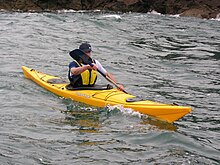




皮艇(英语:kayak,伊努克提图特语:ᖃᔭᖅ 伊努克提图特语发音:[qaˈjaq];尤皮克语:qayaq,意思“猎人艇”)是一种类似独木舟的窄体水上载具,有单人和多人(通常为双人)两种,外型源自亚寒带爱斯基摩人(因纽特人和尤皮克人)和阿留申人传统涉水渔猎使用的兽皮艇。皮艇主要以人力驱动,通常用一支略长的双头桨于艇的左右两边依次划水,但现代设计可能配有用踏轮或电动机驱动的人造腹鳍或螺旋桨。
皮艇比较全体木制的独木舟要轻巧得多,划艇者的座位周围通常有防水的皮或橡胶膜与划艇者的上衣相连,在保证排水量的同时可以防止艇内进水,一般在艇的前后都有水密空间作贮存用。艇内有脚踏,可让划艇者双腿伸直坐立以便休息,并且可以借力帮助上身的划桨,
历史
[编辑]
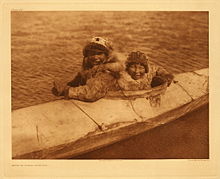


皮艇最开始由东北亚和北美亚寒带的原住民(因纽特人、尤皮克人和阿留申人)发明,用来在内陆湖泊、河流和北冰洋、白令海、北太平洋和北大西洋的沿岸水域进行狩猎。这些原版皮艇的制造方式是将鳍足类海洋哺乳动物(海豹、海狮等)或其他陆生动物的毛皮缝在木制或鲸须(主要是东部因纽特人,因其居住地区在林木线以外)框架上,有至少4000年的历史[2]。最古老的现存皮艇现展览于慕尼黑的五大洲博物馆,源于1577年[3]。
这些原住民使用皮艇的目的也不同。阿留申皮艇(baidarka,源自俄语:Байдарка)通常为双人或三人艇,主要用于狩猎和阿留申群岛各岛屿间的运输。尤皮克和因纽特皮艇(umiak)则是航行外海用的皮艇,长度在5.2—9.1米(17—30英尺)之间,用海豹皮和木框所制,但使用单头桨和多人驾驶。原住民的造船经验是通过口头代代相传,而传统的皮艇通常都是猎手按照自己的体型和操作需求亲手(加上配偶帮助手缝兽皮)制造。
传统的皮艇手会身着因纽特皮衣(tuilik)并且罩在围板上,在关键位置(比如围板口、袖口和帽兜)用束带固定用来密封防止漏水。这种穿着配置使得猎手在万一皮艇发生翻覆后可以轻易用“爱斯基摩翻滚”(Eskimo roll)或同伴相助的方式恢复直立,不需要被迫离开皮艇游泳(大部分因纽特人并不会游泳,因为游泳反而会因为寒冷的极地水温造成失温症更快死亡)[4]。现代的皮艇手通常不穿着皮衣,而是用防水的弹性合成材料制成防水甲板方便密封,同时在需要进出皮艇时可以迅速释放开。
传统皮艇分为三类:最古老的阿留申皮艇常见于白令海和阿留申群岛,形状较圆并且拥有多个颔线,看起来颇似软式飞艇;西格陵兰皮艇则颔线较少、棱角分明,船舷在船首和船尾分别扬起;以及东格陵兰皮艇,形状与西格陵兰皮艇相似,但更为紧身而且在船舷与艏柱之间的夹角更陡,操纵性更好。因纽特人对造艇有非常具体的测量标准——皮艇的长度通常是艇手臂展的三倍,座舱的宽度不超过艇手的臀宽加上两个拳头,高度通常是握拳伸直拇指后的手长。这种常见的尺寸通常是艇长5.2米(17英尺)、艇宽51—56 cm(20—22英寸)、艇高18 cm(7英寸)。因为每个皮艇都各不一样,这使得早期的欧洲探险者当年试图仿制皮艇时迷惑不堪。
大部分阿留申人和格陵兰因纽特人都依赖皮艇进行各种涉海或登陆狩猎,除主要猎物的海豹之外还包括鲸类和陆上的驯鹿。如今,格陵兰岛上的因纽特人仍然使用传统的“外皮套内框”皮艇进行狩猎,因为平软的毛皮在涉水时可以安静的滑过风浪。世界上其它地区也有各种依照传统方式制造皮艇的工匠,但是常常使用帆布或合成布料(比如弹道尼龙)。
现今的传统式皮艇主要源自阿拉斯加、加拿大北部和格陵兰西南的原住民船舶。虽然用现代布料套在木制框架上的折叠皮艇(德语:faltboot或Hardernkahn)最早在1905年由德国慕尼黑的建筑系学生阿尔弗莱德·赫里希(Alfred Heuric)发明并申请专利,并且在1907年由罗森海姆的制造商约翰尼斯·克莱珀(Johannes Klepper)成功量产并在欧洲流行。虽然皮艇在1860年就被苏格兰探险家约翰·麦格雷戈(John MacGregor,1825~1892)引入欧洲,但直到可莱珀的可折叠木框外套防水橡胶帆布的设计才使得这种轻便耐用的新式船舶变得大受欢迎。到了1929年,克莱珀的公司每天要生产90艘折叠皮艇。在其它欧洲制造商也加入后,到了1930年代中期,欧洲估计共有50万艘折叠皮艇被使用[5][6]。
1928年6月,一个叫朗兹·罗默(Franz Romer,1899~1928)的德国人用一个6.1米(20英尺)的航海皮艇带着270千克(590英磅)罐装食品和210升(55美制加仑)饮用水从加那利群岛的拉斯帕尔马斯出发单身横跨大西洋,在58天航行5,060 km(2,730 nmi)后到达美属维尔京群岛的圣托马斯岛,并在休息六周后继续向西航行到达波多黎各,但很不幸在9月13日离开试图继续跨海向纽约北上时恰好撞上奥基乔比飓风葬身海中。

1932年,另一个德国人奥斯卡·斯派克(Oskar Speck,1907~1995)从乌尔姆出发,用皮艇沿着多瑙河穿过罗马尼亚到达保加利亚边境后改道进入爱琴海,随后沿着安纳托利亚西海岸到达塞浦路斯[7]。他原本离开德国是想在塞浦路斯当矿工挣钱,但随后改变主意决定继续东游,通过叙利亚和幼发拉底河穿过伊拉克来到波斯湾,途中缺水少食、忍受酷暑并时常被当地人用枪射击,曾为躲避风暴被困在一个只有一具尸体的小岛上[8]。斯派克到达伊朗后因皮艇损坏不得不停止旅行,等待新订造的皮艇完工,这期间他感染了疟疾。在耽搁六个月后,斯派克继续沿着阿拉伯海边缘航行,数月后到达巴基斯坦并继续筹资,但因当时纳粹德国兴起而被怀疑是德国间谍,不得不仓促离开,在斯里兰卡为躲避西南季风搁置了三个月。之后斯派克到达金奈替换了一个新皮艇,沿着印度次大陆东海岸航行并在1936年1月到达加尔各答,但在缅甸海岸遭遇东北季风被吹偏离,被迫连续划桨30~40小时重新找回航线。在终于到达新加坡后,斯派克再次替换皮艇前往雅加达,但因为脱水加上疟疾复发导致行程减慢,又因为语言障碍被当地人敌视,曾在印度尼西亚遭到20人抢劫(被殴打半死并鼓膜穿孔)靠咬断绳子挣脱后才得以逃脱[9][7][8]。为躲避人祸,斯派克绕远沿着新几内亚北岸航行,最终在1939年8月到达莫尔斯比港,在9月到达澳属托雷斯海峡群岛的赛巴伊岛,但随即就因其德裔身份被当地警方逮捕送进了星期四岛的战俘营,二战结束后才被释放。斯派克跨越三洲七海的整个皮艇旅程耗时7年4个月[10],总里程将近23,000千米(14,000英里)[11][12]。

皮艇在1940年代被引入美国并在缅因州的首届国家白水锦标赛中使用,但是大部分当时参赛的皮艇都在竞赛中损毁,而最终赢得比赛的皮艇则是在翻覆后由艇手抱着游过终点线的[13]。在1930年代后期和1940年代早期,亚历山大·“兹”·格兰特(Alexander "Zee" Grant Jr.)是美国最好的折叠艇手,曾在1939年划渡过恐龙国家纪念区的格林河和在1940年划渡弗兰克·丘奇-不归路河原野的中叉桂鱼河。1941年,格兰特用自己改造装有突梁的折叠皮艇“埃斯卡兰特号”穿越大峡谷国家公园[14][15]。
在1930和1940年代发明的玻璃钢混合树脂复合材料很快就被用来制作皮艇,并且在1950年代开始被广泛使用。1960年6月,西德的激流回旋世界冠军沃尔特·基斯鲍姆(Walter Kirschbaum)首次用一个玻璃钢皮艇划渡大峡谷[16] 。
用橡胶布制造的充气船最早出现在欧洲,而滚塑制造的皮艇在1973年出现。现今大部分皮艇都由滚塑聚乙烯树脂制造。因为这些新式皮艇比玻璃钢皮艇更轻小强韧,在一定程度上促进了自由皮艇运动的发展。
设计原理
[编辑]



通常来说,皮艇的设计是各方面指标之间的取舍,包括航向性与灵活性、稳定性与速度、初级与次级稳定性等等。多体皮艇所面对的取舍则更为复杂。桨手的身材和身型也是整个皮艇系统的一部分,因此也会影响具体的取舍过程。
皮艇的自重也非常重要。不恰当的搬运手段是引起使用者受伤的一个重要诱因[17]。搬运技巧、找他人帮忙和不去使用过于庞大笨重的皮艇可以避免大部分伤痛情况[18]。
排水量
[编辑]如果皮艇的排水量不足以承载自身和艇员加上器材的重量,皮艇就会沉入水中;如果排水量过大,皮艇又会因为吃水太浅而容易招风受浪,使得操纵性受损[19],而且搬运起来也更麻烦。过大的艇身也会产生更多阻力,降低航速并增加对艇手的体能消[20]。而排水量较小的皮艇则更容易进行翻滚操作。另一方面,较高的甲板可以帮助艇手保持干燥,使得应对风浪和自我施救更加容易[19]。许多使用封闭式皮艇的初学者在使用排水量比自身体重大得多的皮艇时会更有安全感[19]。拥有高舷宽体的封闭式皮艇可以拥有较大的排水体积,但是划桨时的感觉远不如低舷窄体的皮艇。
虽然皮艇能产生的浮力必须高于其满载重量,最佳的多余浮力与皮艇的种类、应用目的和使用者的个人喜好有关[19](比如潜水皮艇就几乎没有正数的浮力)。必需的排水量同时也必然收到艇手体重影响而变化范围很大,大部分生产商参照的是65—85千克(143—187磅),有些会降到50千克(110磅).[19][21][22]。所有面向45千克(100磅)以下体重的皮艇都非常宽幅,主要针对初学者。
大约20%的美国人口体重并不在65—85千克(143—187磅)的范围中,要么因为太重(男女各半)导致几乎所有市面上的皮艇都无法承载,要么太轻(大多为女性和青少年,男性不到1%)使得即使驾驭最小的皮艇都有困难[23][24]。驾驭与自己体型相比尺寸过大的皮艇会让人非常疲乏,特别是那些方宽底平的艇身设计。市面上一些皮艇生产商会为了迎合身材较小的成人(特别是女性)和儿童而推出较为狭窄的艇身型号[21][22]。
长度
[编辑]基本的常理是皮艇越长、越窄,船体速度越快、航向稳定性越高,但是操纵性也越差。过长的艇身搬运起来也越麻烦[20],而较短的皮艇存储起来也更方便[25][26]。
用来进行长距离续航的皮艇(比如旅游和航海皮艇)一般较长,长度4.9至5.8米(16至19英尺)。旅游皮艇的龙骨通常比较明显,能够帮助航向性。依赖水流向前行进的白水皮艇因为需要将操作性最大化所以比较短,很少超过2.4米(8英尺)。自由皮艇可能只有1.5—1.8米(5—6英尺)长。休闲皮艇通常会为了稳定性而牺牲速度,并且在航向性和操作性之间进行折中,长度在2.7—4.3米(9—14英尺)。
纵弧
[编辑]皮艇操作性的第二个设计元素是纵弧(rocker),通常在两端最明显。纵弧高的艇身有效水线较短,比如一个5.5米(18英尺)长的无纵弧的皮艇从头到尾都接触水面;而一个同长度的有纵弧的皮艇则船首和船尾都不沾水,有效水线可能只有4.9米(16英尺)。适当的纵弧可以改善操纵性,比如一个有纵弧的白水皮艇可能只比常见的休闲皮艇短1米(3.3英尺),但是水线会短许多而且操纵性也高许多。在冲浪时,纵弧高的皮艇被波浪锁死的概率更低,也更容易进行转弯。
船幅形状
[编辑]
1、初级稳定性高,次级稳定性低;
2、初级稳定性低,次级稳定性一般;
3、初级稳定性低,次级稳定性高;
4、多加两条舭缘线;
5、多加四条舭缘线。
舭缘线越多,横截面弧度越圆润,速度越快,但是稳定度、航向性和吃水面积也越低。



皮艇横截面的宽度叫做船幅,幅宽较大的艇身会更稳定而且可以在保持排水量基础上让皮艇更短。幅宽较小的艇身则阻力更小而且更容易划桨,在风浪中也更容易操纵[20]。
窄幅的皮艇可以适应较短的桨,而短桨对艇手肩部造成的劳损也更轻。但是艇身太窄,可能会引起艇手在坐着的时候产生不适。
稳定性
[编辑]皮艇的初级稳定性(primary stability)指的是当艇手的重量位置发生变化时产生的摇晃程度;次级稳定性(secondary stability)指的是当侧向或垂直受偏转力时艇手感到的稳定性;三级稳定性(tertiary stability)是指在进行皮艇发生翻滚后重新恢复直立的难易程度。
初级稳定性一般只对初学者来说非常重要,而次级稳定性则对有经验的艇手也非常重要。一个宽幅平底的皮艇初级稳定性很高,在平静的水面上非常稳固,但是一旦遭遇风浪就容易翻滚,因为平底一旦脱离水平状态就容易丧失稳定性。相对比,一个窄幅圆底并带有船体外倾的皮艇则可以通过主动倾斜在风浪中保持稳定。初级稳定性适中但次级稳定性良好的皮艇一般更适合航海,特别是在恶劣天气情况下。航海皮艇通常较窄只有56—64厘米(22—25英寸),并且拥有较高的次级稳定性;而休闲皮艇则通常较宽有66—76厘米(26—30英寸)且较为平底,有更好的初级稳定性。
皮艇的横截面形状会影响稳定性、操作性和阻力,而形状通常由圆弧度、平面度以及舭缘线(chine)的数量和角度决定。现代皮艇设计不同部位的截面形状也可能有变化。舭缘线通常可以保证艇身在发生倾斜时仍然能够保持足够宽的有效幅宽,因而会增加次级稳定性。V形的船体航向性会非常好,次级稳定性也最高,但是转弯会更困难。与其相对,平底的艇身更容易转弯,但是更难保持一致的前进方向。圆底的艇身与水面接触的面积最少,因此流体阻力也最小,但是在空载时会因为稳定性太差甚至很难自主保持直立状态。而设计“外皮内框”结构的皮艇时,因为要考虑到艇手骨盆所占的空间,可能无法加设更多的舭缘线[27]。
艇手体型和技术
[编辑]选择皮艇设计时必须考虑艇手的体型。身体重心低的人划艇时会更稳,而重心高的人则更容易倾倒。一般来说,女性的重心要低于男性[19][21][22],可以乘入的皮艇可以比男性窄10%。市面上很少有专为女性设计的皮艇[21],而大部分两性通用的皮艇都是按照男性身材设计的[20]。年轻儿童通常身材较小且体重较低,但是头部尺寸与成年人相似,因此重心相对较高[22]。肩宽较窄的艇手也需要配较窄的皮艇。
初学者通常想要拥有较高的初级稳定性,常见的方式是使用幅宽较大的皮艇。西格陵兰原住民的应对方式是在艇尾的甲板上外绑用木板加上空瓶子提供额外浮力的支腿(outrigger)[22][28][29]。现代的皮艇支腿通常是专业制造厂生产,用于钓鱼皮艇和风帆皮艇上。如果支腿都浸在水中会改善初级稳定性,但是会增加阻力;如果船平衡时支腿都悬在水面上,那么就会改善次级稳定性[30][31]。
船体形状
[编辑]
有些皮艇的艇身是根据形状分类。常见的形状是:
坐位和接触点
[编辑]
传统风格的和一些现代风格(比如开放式)的皮艇都需要艇手双腿向前伸直坐立。其它一些皮艇则允许不同的稍有“盘坐”的坐姿,不需要两腿伸直,这样腿箍部分受力于大腿内侧而不是上侧。
皮艇的使用者必须能够在移动下半身时让艇身也随之晃动,并且可以在每次划桨时都于艇身固定借力,因此绝大多数皮艇都拥有踏脚板和靠背。一些皮艇会固定在艇手的髋部,而另一些则会通过大腿箍进行固定。量产的皮艇通常有可以调节的固定点,许多人还会用泡沫塑料充当垫片来让固定点更稳固和舒适[32]。
皮艇每次划桨会将很多力传导到腿部,因此必须要小心不让膝部伸展过度。而如果膝盖顶住艇仓壁,或膝关节受到扭转,都会造成疼痛甚至劳损。脚部空间不足也会造成抽筋,让划桨效率降低。在乘坐时,艇手应尽量保证自己有一个放松、舒适的坐姿。
材料和构造
[编辑]

Today almost all kayaks are commercial products intended for sale rather than for the builder's personal use.
Fiberglass hulls are stiffer than polyethylene hulls, but they are more prone to damage from impact, including cracking. Most modern kayaks have steep V sections at the bow and stern, and a shallow V amidships. Fiberglass kayaks may be "laid-up" in a mold by hand, in which case they are usually more expensive than polyethylene kayaks, which are rotationally molded in a machine. The deck and hull are often made separately and then joined at a horizontal seam.

Plastic kayaks are rotationally molded ('rotomolded') from a various grades and types of polyethylene resins ranging from soft to hard. Such kayaks are seamless and particularly resistant to impact, but heavy.

Inflatable kayaks are increasingly popular due to their ease of storage and transport, as well as the ability to be deflated for extended portage. Although slower than hardshell kayaks, many higher-end models often constructed of hypalon, as opposed to cheaper PVC designs, begin to approach the performance of traditional sea kayaks. Being inflatable they are virtually unsinkable and often more stable than hardshell designs. New drop-stitch technology means slab, rather than tube shapes are used in the designs with higher inflation pressures (up to 0.7 bar(10 psi)), leading to considerably faster, though often less stable kayaks which rival hardshell boats in performance.

Solid wooden hulls don't necessarily require significant skill and handiwork, depending on how they are made. Three main types are popular, especially for the home builder: plywood stitch & glue (S&G), strip-built, and hybrids which have a stitch & glue hull and a strip-built deck. Kayaks made from wood sheathed in fiberglass have proven successful, especially as the price of epoxy resin has decreased in recent years.
Stitch & glue designs typically use modern, marine-grade plywood with a thickness of about 3至5 mm(0.12至0.20英寸). After cutting out the required pieces of hull and deck (kits often have these pre-cut), a series of small holes are drilled along the edges. Copper wire is then used to "stitch" the pieces together through the holes. After the pieces are temporarily stitched together, they are glued with epoxy and the seams reinforced with fiberglass. When the epoxy dries, the copper stitches are removed. Sometimes the entire boat is then covered in fiberglass for additional strength and waterproofing though this adds greatly to the weight and is unnecessary. Construction is fairly straightforward, but because plywood does not bend to form compound curves, design choices are limited. This is a good choice for the first-time kayak builder as the labor and skills required (especially for kit versions) is considerably less than for strip-built boats which can take 3 times as long to build.
Strip-built designs are similar in shape to rigid fiberglass kayaks but are generally both lighter and tougher. Like their fiberglass counterparts the shape and size of the boat determines performance and optimal uses. The hull and deck are built with thin strips of lightweight wood, often thuja (Western Red cedar), pine or redwood. The strips are edge-glued together around a form, stapled or clamped in place, and allowed to dry. Structural strength comes from a layer of fiberglass cloth and epoxy resin, layered inside and outside the hull. Strip–built kayaks are sold commercially by a few companies, priced US$4,000 and up. An experienced woodworker can build one for about US$400 in 200 hours, though the exact cost and time depend on the builder's skill, the materials and the size and design. As a second kayak project, or for the serious builder with some woodworking expertise, a strip–built boat can be an impressive piece of work. Kits with pre-cut and milled wood strips are commercially available.

Skin-on-frame (SOF) boats are often more traditional in design, materials, and construction. They were traditionally made with driftwood frames, jointed, pegged, and lashed together, and covered with stretched seal skin, as those were the most readily available materials in the Arctic regions (other skins and baleen framing members were also used at need). A "poor man's kayak" might be frameless and stuffed with a snow "frame". Today, seal skin is usually replaced with canvas or nylon cloth covered with paint, polyurethane, or a hypalon rubber coating, on a wooden or aluminum frame. Modern skin-on-frame kayaks often possess greater impact resistance than their fiberglass counterparts, but are less durable against abrasion or sharp objects. They are often the lightest kayaks. Like the older skin-on-frame kayaks, they are often home-built to fit a specific paddler. Engineer Xyla Foxlin built a kayak out of transparent wood as well as LEDs to create a floating vessel that lights up at night, which she calls the Rainbowt.[33]
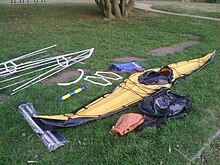
A special type of skin-on-frame kayak is the folding kayak. It has a collapsible frame, of wood, aluminum or plastic, or a combination thereof, and a skin of water-resistant and durable fabric. Many types have air sponsons built into the hull, making the kayak float even if flooded.
现代设计
[编辑]
Most modern kayaks differ greatly from native kayaks in design, manufacturing and usage. They are often designed with computer-aided design (CAD) software, often in combination with CAD customized for naval design.
Modern kayaks serve diverse purposes, ranging from slow and easy touring on placid water, to racing and complex maneuvering in fast-moving whitewater, to fishing and long-distance ocean excursions. Modern forms, materials and construction techniques make it possible to effectively serve these needs while continuing to leverage the insights of the original Arctic inventors.
Kayaks are long—5.8米(19英尺), short—1.8米(6英尺), wide—110 cm(42英寸), or as narrow as the paddler's hips—for example 35 cm(14英寸). They may attach one or two stabilizing hulls (outriggers), have twin hulls like catamarans, inflate or fold. They move via paddles, pedals that turn propellers or underwater flippers, under sail, or motor. They're made of wood/canvas, wood, carbon fiber, fiberglass, Kevlar, polyethylene, polyester, rubberized fabric, neoprene, nitrylon, polyvinyl chloride (PVC), polyurethane, and aluminum. They may sport rudders, fins, bulkheads, seats, eyelets, foot braces and cargo hatches. They accommodate 1-3 or more paddlers/riders.
种类
[编辑]Modern kayaks have evolved into specialized types that may be broadly categorized according to their application as sea or touring kayaks, whitewater (or river) kayaks, surf kayaks, racing kayaks, fishing kayaks, and recreational kayaks. The broader kayak categories today are 'sit-in' (SI), which is inspired mainly by traditional kayak forms, 'sit-on-top' (SOT), which evolved from paddle boards that were outfitted with footrests and a backrest, 'hybrid', which are essentially canoes featuring a narrower beam and a reduced free board enabling the paddler to propel them from the middle of the boat, using a double blade paddle (i.e. 'kayak paddle'), and twin hull kayaks offering each of the paddler's legs a narrow hull of its own. In recent decades, kayaks design have proliferated to a point where the only broadly accepted denominator for them is their being designed mainly for paddling using a kayak paddle featuring two blades i.e. 'kayak paddle'. However, even this inclusive definition is being challenged by other means of human powered propulsion, such as foot activated pedal drives combined with rotating or sideways moving propellers, electric motors, and even outboard motors.
休闲皮艇
[编辑]

Recreational kayaks are designed for the casual paddler interested in fishing, photography, or a peaceful paddle on a lake, flatwater stream or protected salt water away from strong ocean waves. These boats presently make up the largest segment of kayak sales. Compared to other kayaks, recreational kayaks have a larger cockpit for easier entry and exit and a wider beam (69—91 cm(27—36英寸)) for more stability. They are generally less than 3.7米(12英尺) in length and have limited cargo capacity. Less expensive materials like polyethylene and fewer options keep these boats relatively inexpensive. Most canoe/kayak clubs offer introductory instruction in recreational boats. They do not perform as well in the sea. The recreational kayak is usually a type of touring kayak.
航海皮艇
[编辑]
Sea kayaks are typically designed for travel by one, two or even three paddlers on open water and in many cases trade maneuverability for seaworthiness, stability, and cargo capacity. Sea-kayak sub-types include "skin-on-frame" kayaks with traditionally constructed frames, open-deck "sit-on-top" kayaks, and recreational kayaks.
The sea kayak, though descended directly from traditional types, is implemented in a variety of materials. Sea kayaks typically have a longer waterline, and provisions for below-deck storage of cargo. Sea kayaks may also have rudders or skegs (fixed rudder) and upturned bow or stern profiles for wave shedding. Modern sea kayaks usually have two or more internal bulkheads. Some models can accommodate two or sometimes three paddlers.
开放式皮艇
[编辑]

Sealed-hull ("unsinkable") craft were developed for leisure use, as derivatives of surfboards (e.g. paddle or wave skis), or for surf conditions. Variants include planing surf craft, touring kayaks, and sea marathon kayaks. Increasingly, manufacturers build leisure 'sit-on-top' variants of extreme sports craft, typically using polyethylene to ensure strength and affordability, often with a skeg for directional stability.
Sit-on-top kayaks come in 1-4 paddler configurations. Sit-on-top kayaks are particularly popular for fishing and SCUBA diving, since participants need to easily enter and exit the water, change seating positions, and access hatches and storage wells. Ordinarily the seat of a sit-on-top is slightly above water level, so the center of gravity for the paddler is higher than in a traditional kayak. To compensate for the higher center of gravity, sit-on-tops are often wider and slower than a traditional kayak of the same length.
Water that enters the cockpit of a sit-on-top kayak drains out through scupper holes—tubes that run from the cockpit to the bottom of the hull. The cockpit is thus self-bailing. The hull may be sealed, or perforated by hatches and deck fixtures. Contrary to popular belief, the sit-on-top kayak hull is not self-bailing, since water penetrating it does not drain out automatically, as it does in bigger boats equipped with self-bailing systems. Furthermore, the sit-on-top hull cannot be molded in a way that would assure water tightness, and water may get in through various holes in its hull, usually around hatches and deck accessories. If the sit-on-top kayak is loaded to a point where such perforations are covered with water, or if the water paddled is rough enough that such perforations often go under water, the sit-on-top hull may fill with water without the paddler noticing it in time. If a sealed hull develops a split or hole, it will also fill and sink.
冲浪皮艇
[编辑]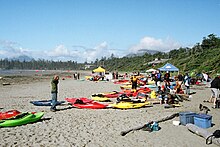
Specialty surf boats typically have flat bottoms, and hard edges, similar to surf boards. The design of a surf kayak promotes the use of an ocean surf wave (moving wave) as opposed to a river or feature wave (moving water). They are typically made from rotomolded plastic, or fiberglass.
Surf kayaking comes in two main varieties, High Performance (HP) and International Class (IC). High Performance boats tend to have a lot of nose rocker, little to no tail rocker, flat hulls, sharp rails and up to four fins set up as either a three fin thruster or a quad finTemplate:According to whom. This enables them to move at high speed and maneuver dynamically. International Class boats have to be at least 3米(9.8英尺) long and until a recent rule change[何时?] had to have a convex hull; now flat and slightly concave hulls are also allowed, although fins are not. Surfing on international boats tends to be smoother and more flowing, and they are thought of as kayaking's long boarding. Surf boats come in a variety of materials ranging from tough but heavy plastics to super light, super stiff but fragile foam–cored carbon fiber. Surf kayaking has become popular in traditional surfing locations, as well as new locations such as the Great Lakes.
冲浪板艇
[编辑]
A variation on the closed-cockpit surf kayak is called a waveski. Although the waveski offers dynamics similar to a sit–on–top, its paddling technique and surfing performance and construction can be similar to surfboard designs.
白水皮艇
[编辑]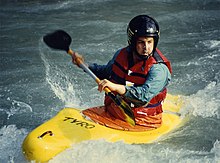
Whitewater kayaks are rotomolded in a semi-rigid, high impact plastic, usually polyethylene. Careful construction ensures that the boat remains structurally sound when subjected to fast-moving water. The plastic hull allows these kayaks to bounce off rocks without leaking, although they scratch and eventually puncture with enough use. Whitewater kayaks range from 1.2至3.0米(4至10英尺) long. There are two main types of whitewater kayak, playboats and river-running boats. Creekboats (for small rivers) and squirt boats are more specialized.
自由皮艇
[编辑]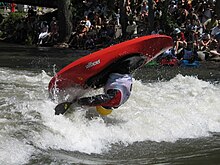
One type, the playboat, is short, with a scooped bow and blunt stern. These trade speed and stability for high maneuverability. Their primary use is performing tricks in individual water features or short stretches of river. In playboating or freestyle competition (also known as rodeo boating), kayakers exploit the complex currents of rapids to execute a series of tricks, which are scored for skill and style.
溪流皮艇
[编辑]The other primary type is the creek boat, which gets its name from its purpose: running narrow, low-volume waterways. Creekboats are longer and have far more volume than playboats, which makes them more stable, faster and higher-floating. Many paddlers use creekboats in "short boat" downriver races, and they are often seen on large rivers where their extra stability and speed may be necessary to get through rapids.
Between the creekboat and playboat extremes is a category called river–running kayaks. These medium–sized boats are designed for rivers of moderate to high volume, and some, known as river running playboats, are capable of basic playboating moves. They are typically owned by paddlers who do not have enough whitewater involvement to warrant the purchase of more–specialized boats.
潜水皮艇
[编辑]
Squirt boating involves paddling both on the surface of the river and underwater. Squirt boats must be custom-fitted to the paddler to ensure comfort while maintaining the low interior volume necessary to allow the paddler to submerge completely in the river.
竞赛皮艇
[编辑]白水竞技
[编辑]White water racers combine a fast, unstable lower hull portion with a flared upper hull portion to combine flat water racing speed with extra stability in open water: they are not fitted with rudders and have similar maneuverability to flat water racers. They usually require substantial skill to achieve stability, due to extremely narrow hulls. Whitewater racing kayaks, like all racing kayaks, are made to regulation lengths, usually of fiber reinforced resin (usually epoxy or polyester reinforced with Kevlar, glass fiber, carbon fiber, or some combination). This form of construction is stiffer and has a harder skin than non-reinforced plastic construction such as rotomolded polyethylene: stiffer means faster, and harder means fewer scratches and therefore also faster.
静水竞速
[编辑]
Sprint kayak is a sport held on calm water. Crews or individuals race over 200 m, 500 m, 1000 m or 5000 m with the winning boat being the first to cross the finish line. The paddler is seated, facing forward, and uses a double-bladed paddle pulling the blade through the water on alternate sides to propel the boat forward. In competition the number of paddlers within a boat is indicated by a figure besides the type of boat; K1 signifies an individual kayak race, K2 pairs, and K4 four-person crews. Kayak sprint has been in every summer olympics since it debuted at the 1936 summer olympics.[34] Racing is governed by the International Canoe Federation.
激流皮艇
[编辑]Slalom kayaks are flat–hulled, and—since the early 1970s—feature low profile decks. They are highly maneuverable, and stable but not fast in a straight line.
冲浪橇
[编辑]
A specialized variant of racing craft called a surf ski has an open cockpit and can be up to 6.4米(21英尺) long but only 46 cm(18英寸) wide, requiring expert balance and paddling skill. Surf skis were originally created for surf and are still used in races in New Zealand, Australia, and South Africa. They have become popular in the United States for ocean races, lake races and even downriver races.
马拉松皮艇
[编辑]Marathon races vary in distances from ten kilometres to over 1000 kilometres for multi-day stage races.
特用皮艇和混合皮艇
[编辑]在现代,任何外形上与传统皮艇相似的双头桨小艇都会被称为“皮艇”。
充气皮艇
[编辑]
充气皮艇(inflatable kayak,也称duckie)通常用氯丁橡胶、丁腈橡胶、聚氯乙烯或聚氨酯布料制成,充气的时候可以使用脚踏、手压或电动气泵。这些皮艇通常会采用水密隔舱设计来提高安全性,并且通常会使用低于0.2 bar(3 psi)的气压充气。
虽然许多在河流和平缓水域使用的充气皮艇都是软式的,高端的充气皮艇通常都设计得较为刚硬,以便在海面使用。近期一些制造商给多隔舱的充气艇加上了可折叠的内部框架增强抗风浪性。
充气皮艇的卖点主要在其泄气后易于搬运、因有一定的柔性和弹性也更加耐用(不像硬体皮艇那样容易磕碰出坑洼和裂纹)、在白水情况下更为坚固(因为碰到礁石可以弹走而不是直接撞毁)、并且可以袋装储存方便。此外充气皮艇通常非常稳定,转弯半径小,而且易于掌握,虽然一些型号划桨起来更加吃力,速度也比传统皮艇更慢。
折叠皮艇
[编辑]
折叠皮艇(folding kayak,也称foldboat)是因纽特人和格林兰传统皮框艇的直系后裔。现代折叠皮艇使用木制或铝合金框架,外包由聚酯、棉制帆布、聚氨酯或氯丁橡胶等合成材料制成的外皮。它们比充气皮艇要更加昂贵,但是刚度和航海性都更好。
瑞士人沃尔特·霍恩(Walter Höhn)在1924至1927年间就制造、研发并在白水河流上试验他的折叠皮艇设计。他在1928年移民到澳大利亚时带去了两艘,在将设计注册了专利后就开始生产。到了1942年,澳大利亚军方与霍恩接触并要求他帮助研发军用皮艇。一共1024艘基于霍恩1942年专利(117779号)的Ⅱ型和Ⅲ型皮艇被先后生产[35]。
脚蹬皮艇
[编辑]脚蹬皮艇(pedal kayak)可以使用自行车踏板式的机构来通过水下的螺旋桨或人造“腹鳍”驱动皮艇。与划桨的皮艇不同,脚蹬皮艇的艇手用腿部肌肉发力,耐力较为持久之外还可以解放双手,因此脚蹬皮艇在垂钓爱好者中比较受欢迎[36]。
双体船和支腿船
[编辑]传统的多体船(multi-hull),比如双体船(catamaran)和装有支腿(outrigger)的划艇可以在不牺牲速度的情况下改善侧向平稳度,而这些技术也被应用到了皮艇上。支腿皮艇(outrigger kayak)可以在艇身侧面配装一个或两个支腿增加稳定性,特别是用于垂钓、旅行、风帆航行和使用摩托皮艇的时候。而双体皮艇(twin hull kayak)则使用两个离中线较远分开的艇身,因此比单纯配有支腿的单体皮艇要更加稳定。
垂钓皮艇
[编辑]
虽然北极地区的原住民通常是用皮艇打猎而不是捕鱼,但近年来皮艇最常见是被用来在温暖地区进行淡水和咸水水域的休闲垂钓。传统的垂钓皮艇通常艇宽较大可以达到1.1米(42英寸),有很好的侧向(初级)稳定性,有些还装有支腿来进一步增加稳定性,甚至有些采用双体船身让艇手可以站起来钓鱼。与摩托艇相比,垂钓皮艇成本低且维修便宜,许多钓鱼艇手还会对皮艇做出个性化的改装。
军用皮艇
[编辑]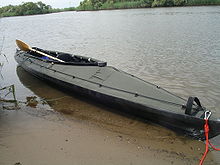
皮艇在第二次世界大战中被投入军用,主要由英国突击队和特种空勤团等特种部队使用,特别是联合作战领航队(Combined Operations Pilotage Parties,简称COPP)、特殊舟艇队和皇家海军陆战队巡逻支队(Boom Patrol Detachment),尤其是曾在弗兰克顿行动(Operation Frankton)中突袭波尔多港[37]。特种空勤团和特殊舟艇队在1982年马岛战争中也使用皮艇做侦察[38]。美国海豹突击队据说在1992年索马里内战初期的统一特遣队(Unified Task Force)行动中也使用了皮艇[39]。
特殊舟艇队现在使用可以基于潜艇(浮出水面时下水,或下潜时用潜水员送到水面)的克莱珀双人折叠皮艇。这些皮艇也可以用运输机伞降或从“支努干”直升机的后舱投下[40]。美国特种作战部队也曾使用克莱珀皮艇,但现在主要使用美国自产的“长途”(Long Haul)牌折叠皮艇[41]。
澳大利亚军队在1941~1945年间的太平洋战争中曾大量使用MKII和MKIII型折叠皮艇对东南亚诸岛实施了33次突袭任务,详细记录可在澳洲国家档案馆的NAA K1214-123/1/06号档案中找到。这些皮艇通常从伪装的舰艇、潜艇、卡特琳娜水上飞机、PT艇和摩托艇下水或伞降投入作战[42]。
参考
[编辑]- ^ 存档副本 (PDF). [2021-09-05]. (原始内容存档 (PDF)于2019-02-14).
- ^ History of Kayak: Eskimos 4000 Years Vision Realized – Kayak Information and Reviews. www.waterkayaking.com. [2021-03-05]. (原始内容存档于2021-06-03) (英国英语).
- ^ (英语) Voelkerkundemuseum-muenchen.de 互联网档案馆的存档,存档日期2008-03-12.
- ^ D.C. Hutchinson, "The Complete Book of Sea Kayaking", 5th ed., Falcon Guides, Connecticut.
- ^ Altenhofer, Der Hadernkahn, Pollner Verlag, 1997, pg 143, ISBN 3925660097
- ^ Dyson, Baidarka, Alaska Northwest Publishing Company, 1986, p 80-81, ISBN 978-0882403151
- ^ 7.0 7.1 Cuthbert, Penny. Oskar Speck : 50,000 kilometres by kayak. Australian National Maritime Museum. 2011. ISBN 9780977547128.
- ^ 8.0 8.1 Escobar, S. Being a hero is all about timing: Oskar Speck's kayak voyage. Australian National Maritime Museum. 2015 [19 April 2021]. (原始内容存档于2021-05-18).
- ^ Prochnau, W. From Nazi Germany to Australia: The Incredible True Story of History's Longest Kayak Journey. Vanity Fair. 2018 [22 March 2021]. (原始内容存档于2021-04-23).
- ^ NSW Sea Kayaker. Incredible Journey [50]. online - reprint from Australasian Post Magazine. 2002 [22 March 2021]. (原始内容存档于2020-11-11).
- ^ Worsley, P. A quarterly publication of the Maritime Heritage Association, Inc (PDF). Maritime Heritage Association Journal. 2007, 18 (3): 13–19 [2021-09-13]. (原始内容存档 (PDF)于2021-03-14).
- ^ “Renew Attempt To Row Boat Across Atlantic,” Messenger Inquirer, April 23, 1928; “In A Rubber Boat Over The Sea,” Baltimore Sun, September 30, 1928; “Rowing Around World In A Canvas Boat,” Bradford Evening Star, November 13, 1935
- ^ “Only Three Shoot Rapids,” Philadelphia Inquirer, July 7, 1940
- ^ Cockleshell on the Colorado, American Whitewater Vol 4, No 2, p 6-13, P2P p 426
- ^ “How It Feels To Run Treacherous Rapids Of Colorado River Related By Altadenan,” Pasadena Post, July 28, 1941><ref Marston, From Powell to Power, Vishnutemple Press, 2014, p 424, {{ISBN|9780990527022}}
- ^ Martin, Big Water Little Boats, Vishnu Temple Press, 2012, pg. 190, ISBN 9780979505560
- ^ Kayarchy - contents of chapter on sea kayaking safety. kayarchy.com. [2021-09-05]. (原始内容存档于2021-04-11).
- ^ Kayarchy - paddling your sea kayak (1) starting out. kayarchy.com. [2021-09-05]. (原始内容存档于2021-04-11).
- ^ 19.0 19.1 19.2 19.3 19.4 19.5 Kayarchy - the kayak. kayarchy.com. [2021-09-05]. (原始内容存档于2021-09-05).
- ^ 20.0 20.1 20.2 20.3 Kayarchy - sea kayak design. kayarchy.com. [2021-09-05]. (原始内容存档于2021-09-05).
- ^ 21.0 21.1 21.2 21.3 Kayarchy - retail outlets (3) sea kayaks & paddles. kayarchy.com. [2021-09-05]. (原始内容存档于2021-09-05).
- ^ 22.0 22.1 22.2 22.3 22.4 Kayarchy - sea kayaking for kids. kayarchy.com. [2021-09-05]. (原始内容存档于2021-09-05).
- ^ 存档副本 (PDF). [2021-09-05]. (原始内容存档 (PDF)于2021-11-03).
- ^ 存档副本 (PDF). [2021-09-05]. (原始内容存档 (PDF)于2011-02-05).
- ^ Car-Topping and Strapping Down a Kayak. Kayak Roof Racks. 2016-05-14 [2018-05-23]. (原始内容存档于2021-09-05) (美国英语).
- ^ How to Store a Kayak. wikiHow. [2018-05-23]. (原始内容存档于2021-09-05) (英语).
- ^ kayakways.net - Kayak Fitting. www.kayakways.net. [2021-09-05]. (原始内容存档于2020-02-24).
- ^ Championships. www.traditionalkayaks.com. [2021-09-05]. (原始内容存档于2021-04-22).
- ^ Greenland National Championships in Sisimiut 2006. [2021-09-05]. (原始内容存档于2021-09-05).
- ^ Hobie Gear SideKick AMA Kit Hobie Kayak Outrigger. [2021-09-05]. (原始内容存档于2019-04-11).
- ^ Outriggers – Wavewalk® Stable Fishing Kayaks, Portable Boats and Skiffs. [2021-09-05]. (原始内容存档于2020-08-12).
- ^ Crowhurst, Christopher. Masik designs for modern kayaks. Qajaq Rolls. 25 September 2012 [2021-09-05]. (原始内容存档于2021-09-05).
- ^ Jason Weisberger. Xyla Foxlin makes a clear kayak with LED lights. Boing Boing magazine. January 16, 2021 [July 8, 2021]. (原始内容存档于2021-11-04).
...(she calls it the 'Rainbowt')...
- ^ ICF - Canoe Sprint. International Canoe Federation. [18 July 2014]. (原始内容存档于8 October 2010).
- ^ Commando Kayak 2011, ISBN 978-3-033-01717-7
- ^ Pedal Kayaks. Mariner-Sails. Mariner Sails Inc. [3 November 2020]. (原始内容存档于2021-11-06).
- ^ Tweedie, Neil. Cockleshell Heroes: the truth at last. 2010-10-28 [2018-05-23]. ISSN 0307-1235. (原始内容存档于August 28, 2012) (英国英语).
|journal=被忽略 (帮助) - ^ James D. Ladd, SBS, The Invisible Raiders: the History of the Special Boat Squadron from World War Two to the Present, Arms & Armour Press 1983, ISBN 978-0-85368-593-7 (p.231)
- ^ Canada's special forces to get ancient war-fighting machines: canoes - The Star. thestar.com. [2021-09-05]. (原始内容存档于2021-09-05).
- ^ specialboatservice.co.uk. www.specialboatservice.co.uk. [2021-09-05]. (原始内容存档于2012-09-15).
- ^ Kayaks | Canoes | Special Operations Forces. www.americanspecialops.com. [2018-05-23]. (原始内容存档于2021-12-20).
- ^ Commando Kayak, Hoehn, 2011.
